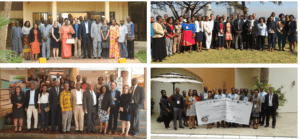
The HIA4SD project is in the process of entering a new phase: Policy dialogues. They will be initiated by multistakeholder meetings in all countries. What is the purpose of these meetings? And what to expect from them? Project leader PD Dr. Mirko Winkler explains in a short interview.
Question: The full project name ‘Health impact assessment for engaging natural resource extraction projects in sustainable development in producer regions’ is quite long. In a nutshell, what is this project about?
MW: The HIA4SD project is an inter- and transdisciplinary research initiative that we have been implementing in four African countries, namely Burkina Faso, Ghana, Mozambique and Tanzania. In the last four years, we have generated empirical evidence on how the extractive industries effect on health in affected communities. In addition, we analyzed the conditions under which impact assessments can be effective to address negative impacts from natural resource extraction and promote sustainable development. Now in the policy dialogue phase, we use this evidence to initiate discussions on how to better promote health and well-being in mining settings. The goal of the policy dialogues is to strengthen the application of impact assessment as a regulatory mechanism to more actively prevent negative effects of natural resource extraction projects on public health.
Question: This sounds like a rather comprehensive research initiative that also involves many non-academic actors, which is great! How exactly will you facilitate the policy dialogue in the project countries?
MW: Since the beginning of the project, many non-academic actors, such as representatives from different ministries, the civil society or the extractive industries have been involved. In the coming weeks and months, the HIA4SD project will continue this dialogue in multi-stakeholder meetings in all four project countries. In these meetings we will, in a first stage, present our research findings, including policy options that were identified to have the broadest acceptability among a range of stakeholders. This will then set the basis for discussions among the stakeholder groups represented, who will be invited to jointly define key aspects to be pursued under the subsequent policy dialogue process.
Question: Besides the multistakeholder meetings, what are other upcoming activities of the project in this phase?
MW: We will be returning to the mining areas where local level data was collected for also informing local actors, including authorities and communities, about the research findings of the project.
In addition, we will offer short courses on health impact assessment (HIA) in all project countries to complement the multi-stakeholder meetings. In those short courses interested stakeholders will learn about the underlying concepts of HIA and they will also go through the various steps of HIA in an interactive manner. The ultimate goal is to strengthen local capacities to conduct HIAs for mining or other large investment projects.
Finally, another series of multi-stakeholder meetings will be held at central level towards the end of the HIA4SD project to review achievements of the policy dialogue and discuss the way forward.
Question: Where can interested people follow the HIA4SD project?
MW: Clearly, our recently launched website, which also includes a news channel, is the best platform to follow our project. The website also features country-specific information on our findings and activities in Burkina Faso (in French), Ghana, Mozambique (in Portuguese) and Tanzania. An additional option to follow our project is over Twitter.
Thank you very much for these interesting insights!
PD Dr. Mirko Winkler is the principal investigator and overall coordinator of the HIA4SD project. He is an environmental epidemiologist who has worked on over 30 HIA for public and private sector entities all over the world.